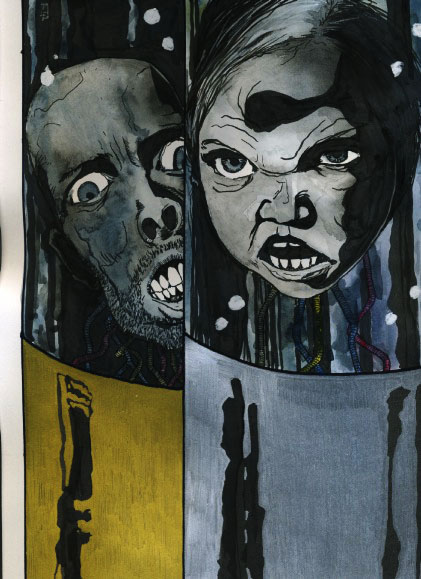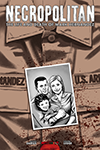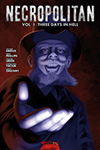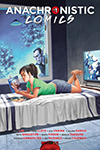 Deep in the Eureka, Kansas bunker, there still exists one Memory Replacement protocol, invented by the late Hemispheres scientist Hans Geisser. It is a cryogenic dreaming sequencing process known officially as “Foreground Switching.” The main engine for this experiment is little Helka Rokich—or at least her head, which has been cooled to a state of permanent physical stasis, but is very much awake psychically. Helka—or at least her brain—is kept, by various psychoactive drugs and auditory stimulations, in a constant R.E.M. sleep cycle, so that she can dream twenty-four hours a day, seven days a week. What she dreams changes the future, at least for the descendants of the Nazi officers’ children known as The Three Uncut Diamonds. Her goal, as outlined by Geisser in his papers and implemented in the software that interfaces with Helka, is to cleanse the Nazi family tree of the bloody legacy that has been inherited by the innocent children of monstrous parents. In this way, the future of these children and of the world does not have to be preordained—the future can be not just newer than the past but better.
Deep in the Eureka, Kansas bunker, there still exists one Memory Replacement protocol, invented by the late Hemispheres scientist Hans Geisser. It is a cryogenic dreaming sequencing process known officially as “Foreground Switching.” The main engine for this experiment is little Helka Rokich—or at least her head, which has been cooled to a state of permanent physical stasis, but is very much awake psychically. Helka—or at least her brain—is kept, by various psychoactive drugs and auditory stimulations, in a constant R.E.M. sleep cycle, so that she can dream twenty-four hours a day, seven days a week. What she dreams changes the future, at least for the descendants of the Nazi officers’ children known as The Three Uncut Diamonds. Her goal, as outlined by Geisser in his papers and implemented in the software that interfaces with Helka, is to cleanse the Nazi family tree of the bloody legacy that has been inherited by the innocent children of monstrous parents. In this way, the future of these children and of the world does not have to be preordained—the future can be not just newer than the past but better.
It has been some time since Control retired from Hemispheres and took up residency in the Eureka bunker. I use the expression “some time”, because, honestly, I have no idea how long it has been, as my sense of temporal reality seems to have been permanently altered by my recent encounter with my own head. (That is, if the event was recent at all. It could have taken place years—or even decades—ago, for all I know. It would certainly help to explain memory loss and my constant state of distractedness. What does it mean to see your severed head, anyway? Is this necessarily the same as seeing that your head has been severed? And does seeing necessarily equate with feeling, with the sensation that your head is missing? How would you know this? How and where would your brain still be operating?) Control appears to be living in the bunker in a state of semiretirement. He has his own efficiency apartment below ground and also spends time experimenting in a shed that is on the surface, a few miles above the laboratory. Control commutes back and forth between surface and bunker via an elevator that is part of a network of Maglev trains heading out on spurs to various destinations. Scientists and buyers come and go through a terminal at one end of the bunker. The cost of keeping all this functioning must be astronomical.
I know so many details about the bunker because my own severed head is being stored there and I am telepathically linked to the vast network of surveillance cameras that keeps tabs on the workers and monitors the status of the canisters where the other heads are stored. And when I write that my head is stored in the bunker, I mean to say that my other head is stored there, the one that is not currently resting on my neck and shoulders. (Having lost my head has given me a new perspective on the impreciseness of the vernacular saying, “He has a good head on his shoulders.”) At least this is my current thinking on this particular topic. I can only assume that this paradox of possessing both a severed head and a fully attached head is a result of my own bifurcation. I suppose that what goes around comes around, where bifurcation is concerned. I’ve seen it happen in so many others, I have absorbed their condition and made it my own. Isn’t that what a storyteller does? And I am nothing if not a storyteller. In one version of the story, I was evidently decapitated and in the other I was not. The thing is that the two versions of the story co-exist without ever becoming two separate stories. It’s more like branches on a tree—same bark, same skin, same blood. It’s hard in my darkest moments not to think of losing one’s head as being punitive, as punishment for some real or imagined crime or transgression. I have to let go of this, though—the “why me? It’s not fair” plaint. It’s like in the fairy tale in which one twin was beaten and the other was not. There doesn’t have to be a reason for this inequity, and one is never given. One twin wasn’t evil and the other good, anymore than one of my heads was evil and the other wasn’t. Or, for that matter, the combination of one particular head with one particular body was not necessarily a bad combination. Whether I was decapitated by my father, when he was Mishka the Bear, is a question that can only take me even farther into the dark woods of Grimm parenting, where I fear I will become permanently lost if I let my mind go wandering off there. So, I won’t.
Shortly after I opened The Moth’s hatbox in Control’s office, and came face-to-face with my other head, I remember hearing a stream of gas pouring out of hidden nozzles along the wall and feeling rather lightheaded. The last thing I saw before passing out was a group of Hemispheres cleaners entering the office and taking the hatbox away with them. I then fell into a dreamy darkness from which I have yet to awaken. I am entirely lucid in my dream state and I am able to reason, feel intense emotion and can, at least to a certain extent, guide, if not entirely control what I am experiencing. I have been able to deduce that my severed head was taken by the cleaners to the Eureka lab and placed in a single gold canister that sat in the middle of a row of other, plainer canisters. My head was shaved, revealing a tattoo: Hh. Of course, I would have to possess eyes in the back of my head to see this tattoo, but since I don’t, dreams are a fair substitute. I didn’t know it at the time of my initial shelving, but the buzz emanating from the surrounding heads (a mix of awe and envy) has since led me to surmise that mine was the final head necessary to complete the sequence that would in turn activate Control’s doomsday weapon, “The Theremin Rift.” Meanwhile, I and my other attached head were taken to a Downtown Sleep Study Center where we have been living ever since. (Since I am technically in a coma, I have had to temporarily suspend the writing of this memoir. I am unsure if my psychic projections have been translated into printed form, but if not and you can still hear me it means that I am probably communicating with your mind telepathically. Don’t be afraid. Think of this as a very local, members only broadcast without commercial interruption or pledge drives. You don’t worry about the television in your family room radiating your brain or the brains of your children, do you? Or, if you do worry, you don’t worry enough to turn your TV off. You may experience a bloody nose or slight itching in your hands when you wake up, but these side-effects wear off, a lot quicker than some dreams and memories I know.) I am not really sure why I was taken to the Sleep Study Center, but evidently there is more to taking over Hemispheres than I originally thought or could ever imagine. I have been told (through implanted electromagnetic messages presenting as spoken words) that my body and mind need to be prepared for my new organizational role. All the voices I hear seem very deferential, but I am essentially a prisoner, like a foreign king who was captured in battle and is now being ransomed. There can be no doubt that Hemispheres scientists are experimenting on me and studying my dreams. Before leaving Hemispheres, Geisser developed a device for projecting dreams onto a screen so that they could be analyzed, although projected dreams are very different from how they appear to the dreamer in the context of sleeping. The projections are more like foreign films that are subtitled in one language and dubbed into another. (Geisser was an old movie buff who liked to say of the classics, “They had dreams back then, big dreams, giant ones, great as all outdoors.”) The sensory overload and temporal lag created in the dreamer sometimes result in him not knowing his own mind. And yet, he finds it difficult to get outside of his own head. Instead, other heads come to him…that is, to me.
My severed head is now the receiving hub for the dream transmissions of all the other Theremin heads that are with me in cryogenic lock-up. I then transmit this data to my still attached head through his bedside baby monitor at the Sleep Center. It’s difficult for me to know my own mind when so many other minds have become my dependents. I’m like the parent whose house is filled with his kid’s childhood belongings while the child is still occupying that suspended state between leaving home and achieving true independence. Every one of these children has the potential to change the world in some way, although fewer possess the will or the power to destroy it. A man who may or may not be Cary Grant explains this all to me right before he begins probing my brain in order to unlock the code that will activate The Theremin Rift. (Now that you mention it, Cary Grant is dead, so I must be dreaming him too. He is appearing in place of someone else, presumably a result of Memory Replacement Therapy.) It is amazing how many of our dreams are about the same television programs that we watched as kids and that we all remember acting in them. Although, I suppose even my severed head should know enough by now not to be surprised by any of this. Especially, my severed head.
“Hemispheres,” Grant explains, sticking a very large electrode into my amygdala, “is about to evolve a new form of tradecraft and you are at the center of that headless evolution. Stop—reverse that. You are at the center of where that evolution is headed.” Grant, who obviously has himself undergone The Wonka Protocol, says that he is conducting a battery of psychological stress tests on me to make sure that I am up to the task of leading the organization when it enters its altered, metaphysical state.
“Is this going to hurt?” I ask.
“Yes,” he says. “Very much. You may also think you taste chocolate.”
While each of the heads has a distinct viewpoint, the most active dreamer is Helka. She is the voice I pick up most often inside my amygdala. I occasionally encounter interference in the transmissions. Is there a competing network somewhere out there? At this point, it’s a stretch for my mind to even conceive of there being a “somewhere out there”, that is, an outside to my inside. But I tell myself (if I can even reference a “myself” at this point) that without an outside there are no borders, and there must be borders. Otherwise, how can you know where you are, where you really are? This is what comes of severing—radical disjointedness and self-contradiction. It’s like having a conjoined twin who is attached to the back of your head and is facing backwards. Having eyes in the back of your head (which, again, I do not) does not vanish blind spots. And there is the added disadvantage of having to constantly fight with yourself about a direction in which to walk. It’s not a place you want to be. But then, where are you, what is “place”, and what is “being” in this state? What is the state of Kansas? Is it like Ohio? It doesn’t feel like Ohio, but then, Ohio doesn’t really feel like anything at all. Recently (?) I was able to train my mind to search the airwaves for the competing psychic network that is causing so much static. It turns out that this other transmission originates inside a secret Disney world called Diamondland, a location that, admittedly, I was starting to doubt ever existed. I seem to have formed a visceral connection to the prison city, as if the messages are meant for me alone to hear. I have access to a number of live feeds, like webcams installed on the tops of buildings. When I concentrate, I can focus on the streets below or actually see into the windows of apartment buildings. Although I have been able to gain access to surveillance cameras blanketing most of Diamondland, I still can’t zoom in far enough to identify people’s faces. Again, there are blind spots. Once I thought I saw my father, then my sister, but they were probably only the shadows that blind spots present when they have been discovered. I sense that Diamondland is at the point of expanding into one gigantic blind spot and that once this occurs the souls imprisoned there, along with their secrets, will disappear forever. One of their secrets has to do with who I am. I know that this is so and that the situation is urgent, time-sensitive, and dire. I know this because my head has been severed from my body, which is a sure sign that my personal identity is in jeopardy.
* * *
I was recently discharged from the Sleep Study Center. Evidently, whatever Hemispheres scientists needed to do to my brain to prepare me for my new role in the organization has been accomplished. There are now permanent wireless communication lines running from the attached head on my shoulders to my severed head in the bunker. To say that I am of two minds about this would be a bad joke but not far from the truth. I feel like my brain is pulling double duty, but I guess you have to expect this if you want to be the boss. Mind you, it’s not that I want to be the boss; it just appears that I am going to be. Although I still spend much of my day in a dreamlike trance, I am physically back at Hh (Hemispheres headquarters) and slowly recovering a sense of reality, but it’s a new reality and I cannot be sure that it is even my own. I live in an apartment on the top floor of Hh that was once used by Control for his personalized training of Honeypots. Slowly, I am learning details about how this organization operates and I am becoming more and more involved in its day-to-day administration. Not all my activities involve saving the world. A large portion of my job is bureaucratic in nature. Every once in a while a legal team will enter my office with briefcases and expect me to sign a thick stack of papers. I am also called to meetings that have to do with major issues like the assassination of a foreign leader or minutiae like the price of soda in the employee lounge. I am allowed to roam anywhere in the building now. My badge gets me into all levels. But many of the offices are empty. I can find no hidden files that might shed light on the disappearance of my family. If there are secrets to be discovered, Control evidently kept them hidden even from himself. It’s as if Hemispheres has its own agenda. I’m only the guy in the control booth pushing illuminated buttons in a predetermined sequence.
























